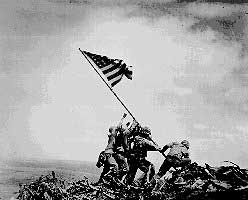The Battle of Iwo Jima
Iwo Jima is an eight square-mile island of sulfuric sand and volcanic ash. It is 700 miles south of Tokyo.
The Japanese put radar stations on Iwo to warn of approaching B-29's which regularly flew right over it on
bombing runs to Japan. The Japanese also had fighter planes on the two airstrips.
Tokyo knew the Allies were interested in Iwo Jima so they put a garrison of 21,000 troops, under General
Tadamichi Kuribayashi. These troops built up the island to one of the strongest defenses in the Pacific. They
added 1500 pillboxes and block houses, trenches, and hundreds of connecting tunnels. Mt Suribachi was even
honeycombed. For the Japanese on Iwo Jima this was the end of the line. There was no hope of rescue from the Imperial
Fleet.
On the marines side, General Harry Schmidt commanded the 4th & 5th divisions. Navy battleships, cruisers,
and carrier aircraft bombarded the island for three days prior to the landing. On 19 Feb 1945 the marines
came ashore on a long black sandy beach on the southern side of the island. The 4th & 5th marines fought
their way from shore to shore cutting Iwo in half and separating Mt. Suribachi from the rest of the island. By
night fall, the marines were firmly ashore but suffered heavy losses of 2400 casualties, including 600 dead.
Mt Suribachi was secured in four days as the marines fought yard by yard. The Japanese had to be rooted out of
holes and caves, by grenades, satchel charges, and flame throwers. Then with the Japanese soldiers popping up or
faking death, the same ground retaken yard by yard again. On 23 Feb the marines finally reached the
summit.
On the flat surface, the 4th, 5th, and later the 3rd divisions concentrated on the Motoyama Plateau , aided by
marine and naval aircraft who flew close support missions of strafing, bombing, and dropping napalm, within
yards of the forward troops. Both airfields were slowly overrun and the Japanese were pushed toward the northern
tip of the island. But as the Allies had perfected their technigues of air, ground, and naval coordination, so
had the Japanese on their defensive tactics. No more Bansai attacks which left the battlefield littered with
dead Japanese and accomplished very little. This time the Japanese wanted to take the marines with them. As confident
marine and naval planners estimated Iwo Jima could be secured in five days, in actuality it took almost a
month.
In the end Iwo Jima was the bloodiest battle of the Pacific war as the marines and sailors suffered 6,800
killed and more than 18,000 wounded. Of 21,000 Japanese soldiers on the island, 200 were taken prisoner,
more than 20,000 were killed.
Twenty-six Medals of Honor were awarded, twelve posthumously. Even before the island was secured, crippled
B-29's were landing on the airstrips and by war's end more than 2200 would be making emergency landings.
 The American flag being raised on Iwo Jima
The American flag being raised on Iwo Jima
Special thanks to the Hitchcock Herald
Back
This page hosted by  Get your own Free Home Page
Get your own Free Home Page

